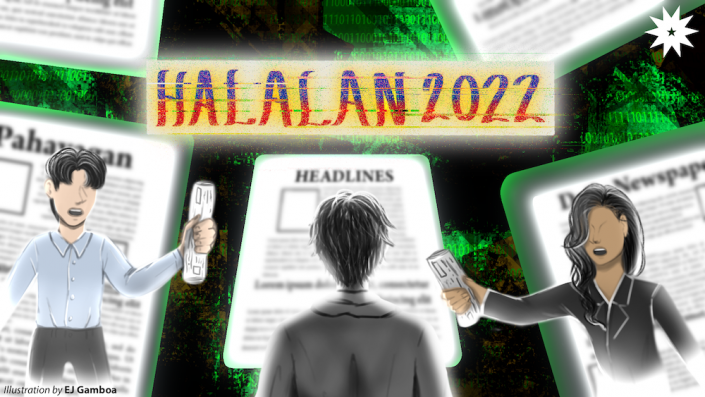As voting day nears, political headlines constantly fill television news shows, social media timelines, and other platforms for reportage. Voter surveys, which aim to reflect the people’s choices and to give a sense of the nation’s impending future, have also begun to resurface. With these serving as the voices of the voters, campaign advisors have utilized polls to mobilize strategies for their candidates, even if such strategies involve the risk of throwing away productive electoral discussions. After all, candidates would do whatever they can for their names to make the headlines.

Initiating number contests
Surveys, while being a supposed tool for further candidate exploration and campaign strategizing, actually have been among the most seen headlines this election season. As months progressed, polling firms were met by result-hungry supporters who would either point out flaws to discredit the poll or to assert their dominance by citing the poll outcomes. Discussions on poll reliability, probability of number hikes, and candidate winnability have taken center stage on this matter. As such, candidates from opposing camps create their own interpretations of the polls and then utilize them to strategize further plans and stimulate supporters.
Despite its prevalence, a Social Weather Stations (SWS) report dated September 2017 noted that these surveys do not necessarily influence a lot of voters. The gathered data shows that 84 percent of the 2016 elections voters’ choices were not in any way affected by the poll results. Department of Political Science Associate Professor Dr. Cleo Anne Calimbahin affirms this and says that surveys “won’t capture voter perception.”
Beyond the usual polls by acclaimed firms, the audience has also resorted to looking into informal social media and street polls, which are sometimes led by the media themselves. Among these are Google Trends and rally attendance tallies, which people deem as estimators for election outcomes. This shows how this has become a game of who gets the highest numbers, which potentially distances voters from advocacy-based discussions.
Custom-made personas
Aside from numbers, another shaper of political discussions and reportage has been personality politics. This pushes candidates to humanize themselves, be it through advertisements, sorties, or entertainment show attendances. A study in 2020 asserted that putting a hint of entertainment in political campaigning pushes voter engagement to a more emotional route. According to the 2017 SWS report, 40.4 percent of the respondents base their votes on the candidates’ personalities whereas 57.3 percent base them on platforms.
Calimbahin explains that this strategy lies in the candidates’ need for name recall—in hopes that it would be easier for voters to identify their names on the ballot. She then puts forward that setting this strategy forth at the expense of platform-based discussions is a structural problem. “We do not have genuine programmatic political parties. Political parties should be campaigning [for] programs and platforms. The burden is on the parties,” she explains.
The first phase report of the University of the Philippines Digital Public Pulse (DPP) Research Project released in February 2022, which investigated trends and interactions across social media networks, also identifies political interactions on social media as more identity-based than platform-based. “Identity-based politics, [such as those hinging on] regional identity [and] political affiliation, are ingrained in Facebook social formations, restricting issue-based dialogue and public interest agenda setting,” DPP’s Facebook report reads.
Under the surface
While identity-based and number-based politics continue to overshadow candidate advocacies and shape pre-electoral discussions, it is inarguable that all these are a part of peoples’ right to free speech. Despite Comelec’s attempts in imposing bans on pre-elections polling and exit polling, the Supreme Court ruled that blackouts in poll results suppress the polling bodies’ and the media’s democratic rights. This likewise applies to personality-based shows.
However, the lack of platform-based discussions is just the tip of the iceberg. A much bigger problem—the public’s media consumption behavior—also exists. After all, issues surrounding election reportage are more concerned about its implications to the consumers.
DPP’s report reveals that news has become secondary to non-political pages and social media influencers when it comes to sources of political information. Hyper-partisan media, which are “news and political channels that guise their content as ‘news’ or informational,” have also been observed to be on the rise on YouTube. This tells a lot about the news media’s detachment from its intended audience.
“The declining centrality of news media as a source of credible political information is detrimental to political knowledge of voters who may be getting information from sources that do not possess the rigor and principles of journalistic practice,” the report cites.
This evident divide between mainstream media and the audience signals the need for massive change in the media industry’s and the government’s strategy in engaging voters.
Reshaping election reportage
Calimbahin believes that the spark in improving the overall quality of election reportage in the Philippines is the generation of more advocacy-based discussions.
“[The] media can still improve on reporting [by asking] candidates [more] about their platforms and programs,” Calimbahin asserts.
With regard to poll reportage, SWS President Mahar Mangahas, in a Lente Pilipinas’ webshow, Survey Says! Election Surveys and the 2022 National Elections, points out that ensuring reporters have statistical knowledge, which promotes precision journalism, is the key to assure that voters realize what these surveys ought to be: gauges aiming to reflect current realities.
“Tandaan lang na ‘yung surveys sa communication, ‘yan ay pandidinig, hindi pagsasalita,” maintains Mangahas, highlighting that pre-poll reports must solely be a snapshot in time and not a voting compass.
(Surveys listen—not speak—to the public.)
DPP’s report, meanwhile, addresses the need for media companies to “rethink their news broadcast distribution models” in order to foster a more news-engaging public.
As the country wraps up another election season, Filipinos once again are to bag lessons when it comes to reportage and information consumption. Definitely, the media and the polling body would still need to tread a long way in letting voters see that there is more to a candidate than just personalities and numbers.
